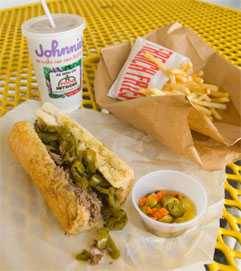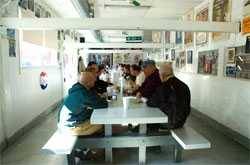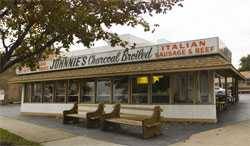Chicago Rolls for Chicago Roast Beef
There's no need for a special trip to Chicago when armed with this amazing Italian beef sandwich recipe.
Created on the Sout Side of Chicago (they say Sout on the South Side), in the Italian enclaves around the now defunct Stockyards, the classic Chicago Italian Beef Sandwich (pronounced sangwitch) is a unique, drippy, messy variation on the French Dip (which is not a sex act). It is available in hundreds of joints around the city, and rarely found beyond its environs until now thanks to our delicious recipe. If you're looking for a quick authentic Chicago Italian beef sandwich recipe then this is not the one for you since the true magic comes from a roast that has been cooked low and slow, creating the best Italian beef you've ever sunk your teeth into!
So where did this delicious combination of meat, drippings, and pickled vegetables come from? While the exact origin is unknown, the sandwich was probably created by Italian immigrants in the early 1900s as they rose from poverty and ground meat into the middle class, when they were able to afford beef for roasting. One anonymous reader has written to me to tell me the inventor was a Southern black man in jail with one of the Scala brothers. It was then was popularized by Pasquale Scala, a South Side butcher and sausage maker. During the Depression, in the late 1920s, when food was scarce, Scala's simple Italian beef sandwich of thinly sliced roast beef on a bun with drippings and fried peppers took off. Today, beef sangwitches are a staple at Italian weddings, funerals, parties, political fundraisers, and lunches "wit my boyz".

Chicago Italian Beef is made by slowly roasting lean beef on a rack above a pan filled with seasoned beef-based stock. Some folks call it gravy, but in most Chicago Italian households gravy is a term reserved for tomato sauces. Others call itau jus or "juice" for short, although it is often made with bouillon, and that is not technically au jus, which normally refers to natural cooking juices. Let's just call it juice, OK?
Then it is sliced paper thin, soaked in the hot juice for a few minutes, and layered generously, dripping wet, onto sections of Italian bread loaves, sliced lengthwise. This crust is typically tan, only slightly crumbly, fluffy and white in the center, and high in gluten. According to Allen Kelson, former restaurant critic forChicago Magazine, it is important that the bread has, what Bounty Towels calls "wet strength". This comes from long fermentations, he explains. The more accelerator, the worse the bread, as far as Italian beef goes. French breads just don't cut it, he says.
The meat is topped with sautéd green bell pepper slices andgiardiniera. The most popular commercial brand of giardiniera, Dell'Alpe, is simply a condiment of hot pickles serrano peppers, celery, green olives and spices packed in oil. Others, like my recipe for giardiniera, include carrots, cauliflower, and more. Finally more beef juice is spooned over the toppings, making the bread wet and chewy. Many stands will dip the whole sandwich in juice if you ask. You can ask for juice for dipping on the side, but then everyone will know you ain't from around here.
Devotees, such as my Sout Side Italian-American wife, say it should only be topped with Melrose peppers, a long slender, thin-walled sweet green pepper that was brought over from Italy and was named for the suburb of Melrose Park, home to many immigrants. They are sautéd in olive oil and served whole, with seeds. Virtually no restaurants make it with Melrose peppers because they are not grown commercially, but many home cooks/gardeners, including my wife's family, cultivate this variety just for sangwiches and "peppers & eggs" (a popular Italian American breakfast in Chicago restaurants). Some restaurants get fancy and use colorful sautéd red peppers or yellow peppers in their Italian Beefs.
Traditionally it is cooked indoors but you can do it on the grill or smoker and amp it up a notch. This dish is especially well-suited for the rotisserie. You can even cook the whole thing a day or so in advance and serve it from a slow cooker making it perfect for game day.
My Chicago Italian beef sandwich recipe is triangulated from several sources. Everyone has their own secret. Many, like Al's #1 (my fave), put the meat in the juice, submerged half way while it roasts rather than hovering above it. My brother-in-law, who once owned an Italian deli and makes the best Italian beef I know, takes the time to cut slits in the meat and stud it with slivers of fresh garlic and onion slices. He also uses a mysterious ingredient named Fogeddaboudit. Whenever I ask him for the secret to his Italian Beefs, he says "fogeddaboudit." Find my take on this classic sandwich below!
Heading to Chicago? Here are the best Italian beef stands.

There are scores of Italian beef stands in Chicago, and Italian beef sandwiches are available at most hot dog stands. Some purchase pre-cooked beef and juice from Scala's, but the best make it from scratch. Prices typically range from $3.50 to $6.50 for a sandwich. Below are some of my faves listed in order of preference. Let the arguments begin! Post your opinions below in the comments section.
Note: Since I wrote these reviews the Travel Channel did a showdown between Al's & Mr. Beef, with Mr. Beef winning 3 votes to 2 from their "judges" one of whom confessed on air he'd never been to either. I mean how can you live in Chicago and never get to either and know anything about Italian Beef Sangwiches? DOH! There were several problems with the judging. Worst of all, they topped both sandwiches with giardiniera, an optional topping, that is very hot! You can't taste the meat through giardiniera, so it was really a giardiniera tasting! STOOPID!
I stand by my ratings.

1) Al's #1 Italian Beef.Reviewed: 1079 W. Taylor St., Chicago. Now franchised to several locations, the original, founded in 1938 in Little Italy, is on everyone's top five list. The meat is top sirloin. The gravy is rich and flavorful, and that's their secret. Great, buttery, skin-on fries, that are not too salty. No toilets, the counter will handle 6-8 people standing up, there is no indoor seating, but there are three picnic tables out front. Watching the world go by in Little Italy is as entertaining as the opera. There is a parking lot, and Mario's Italian Ice is across the street.

2) Mr. Beef.Reviewed: 666 N. Orleans St., Chicago. A celebrity and tourist fave. Jay Leno has said it's his favorite authentic Chicago Italian beef sandwich, and his picture is prominently displayed on the wall along with numerous other lumiroti. The parking lot and attendant are worth the price of admission. Not far from downtown. The beef butt is cooked on the premises.

3) Johnnie's Beef.Reviewed: 7500 W. North Ave., Elmwood Park (just west of Harlem on North Ave., in an Italian suburb). Long and skinny inside, there is standing room only for about 20, and 5 outdoor picnic tables alongside the ample parking. The beef is juicy and very tender with lots of fresh black pepper bite. The shoestring fries are first rate. Don't miss the home made Italian ices.

4) Freddie's Pizza & Sandwiches.Reviewed: 701 W. 31st St., Chicago. In the shadow of Comiskey Park (sorry, I just can't bring myself to call it by the official corporate sponsored name). Plenty of real tables with seating for about 50, two toilets, a TV for watching the Sox games, and a mural of Venice. There's always a table or two of gray hairs talking with their hands. The standard Italian Beef Sandwich is very wet, almost too hot and crumbly to pick up. I've been known to resort to knife and fork here. But I'm not complaining because the juice is among the best. The giardiniera is more vinegary than most.
Other noteworthy joints

Carm's Beef & Snack Shop.Reviewed: 1057 W. Polk St., Chicago. Old-fashioned Little Italy family owned and operated sandwich shop on a back street. To be honest, I'm not thrilled with the crumbly meat, but I love the clean ambiance (even the unisex washroom is spit-spot), and that there is a long counter with stools. Alas, parking is nigh impossible. The staff is colorful and familial. Owner Mary DeViro is awaiting your order.

Ricobene's. Reviewed: 252 W. 26th St., Chicago. This long-time Bridgeport favorite, founded in 1946 and revered by many, alas, has fallen out of my top ranks of Italian Beef destinations, perhaps because they are opening branches everywhere. The meat is tough and the gravy bland. Stick with the excellent Breaded Steak Sandwich washed down with a beer.

Buona Beef andPortillo's (above) make good beef sandwiches, they are not among my top 10. But they do sell beer…
Now on to my own Chicago Italian beef sandwich recipe.
Authentic Chicago Italian Beef Sandwich Recipe

Tell others what you thought of it and give it a star rating below.
Chicago Italian Beef is made by slowly roasting lean beef on a rack above a pan filled with seasoned beef-based stock. Some folks call it gravy, but in most Chicago Italian households gravy is a term reserved for tomato sauces. Others call it au jus or "juice" for short, although it is often made with bouillon, and that is not technically au jus, which normally refers to natural cooking juices. Let's just call it juice, OK? It's what keeps the sandwich nice and moist.
Serve with: diet cola.
Makes:
10 well-stuffed sandwiches
Servings:
Takes:
The Beef
- 3 pounds boneless beef sirloin or round roast
The Rub
- 1 tablespoon ground black pepper
- 2 teaspoons garlic powder
- 1 teaspoon onion powder
- 1 teaspoon dried oregano
- 1 teaspoon dried basil
- 1/2 teaspoon crushed red pepper
The Juice
- 6 cups hot water
- 4 cubes beef bouillon (yes, bouillon, see the explanation below)
The Sandwich
- 10 soft, fluffy, high gluten rolls or a big Italian bread loaf (Gonnella, Turano, and D'Amato are the bakers of choice in Chicago)
- 3 green bell peppers
- 2 tablespoons olive oil
- 1 cup spicy hot giardiniera
About the beef. Top sirloin, top round, or bottom round are preferred in that order. For tenderness, especially if you cannot cut paper thin slices. My friend David Rosengarten, the famous cookbook author and TV chef, uses chuck, a fattier cut, so the meat will be more tender and flavorful. "Luxurious" is the word he used.
About the rub. Notice there is no salt in the rub. You'll get plenty from the bouillon. If you wish, omit the garlic powder and stud the roast with fresh garlic.
About the bouillon. I have encountered lively debate on the makeup of the juice as I developed this recipe. Some insist you must use bouillon to be authentic, while others use beef stock, veal stock, or a soup base, and simmer real onions and garlic in it. The bouillon advocates have won me over on the authenticity argument, although I must confess, soup base is my favorite. Soup base is stock concentrated into a paste. It usually has salt added. Click here to read more about stocks, bouillons, consommé, etc. Feel free to substitute soup base or, best of all, make your own stock.
Beware. This recipe is designed for a 9 x 13" baking pan. If you use a larger pan, the water may evaporate and the juice will burn. If you have to use a larger pan, add more water. Regardless of pan size, keep an eye on the pan to make sure it doesn't dry out during cooking. Add more water if necessary.
Quick and easy shortcut. My wife makes a darn tasty Italian Beef Sangwitch by simply dusting the meat with unmeasured herbs, garlic, salt, pepper, and oregano, and then she browns it on all sides in a frying pan with some olive oil. She then deglazes the pan and that's her gravy. It goes in a pan under the meat in the oven during roasting. I love it (but not as much as I love mine and I hope she doesn't read this).
These recipes were created in US Customary measurements and the conversion to metric is being done by calculations. They should be accurate, but it is possible there could be an error. If you find one, please let us know in the comments at the bottom of the page
-
Prep. If you wish, you can stab the surface of the meat every inch or so and stick slivers of fresh garlic into the meat as does my brother-in-law. If you do this, leave the garlic out of the rub. Otherwise, mix the rub in a bowl. Coat the meat lightly with water to help the rub stick, sprinkle it generously on the meat, and massage it in. There will be some left over. Do not discard it, we will use it in the juice.
-
Fire up. If you are cooking indoors, put a rack just below the center of the oven and preheat to 225°F. If you are cooking outdoors use a 2-zone setup or a smoker and get it the oven or the indirect side up to about 225°F.
-
Cook. Pour the water into a 9 x 13" baking pan and heat it to a boil. Dissolve the bouillon in the water. It may look thin, but it will cook down and concentrate during the roasting. Pour the remaining rub into the pan. Place a rack on top of the pan and place them both on the indirect side of the grill or in the oven indoors. Place the roast on top of the rack above the juice. Roast at 225°F until interior temperature is about 130-140°F for medium rare, about 3 hours (exact time will depend on the cut of meat, its thickness, and how well calibrated your cooker is). This may seem long, but you are cooking over water and that slows things down. Don't worry if there are people who won't eat medium-rare meat. The meat will cook further in step 5, and you can just leave theirs in the juice until it turns to leather if that's what they want.
-
While the meat is roasting (mmmmm, smells sooooo good), cut the bell peppers in half and remove the stems and seeds. Rinse, and cut into 1/4" strips. Cook the peppers in a frying pan over a medium high heat with enough olive oil to coat the bottom, about 2 tablespoons. When they are getting limp and the skins begin to brown, about 15 minutes, they are done. Set aside at room temp.
-
Prep again. Remove the roast and the juice pan. Take the meat off the rack and remove the rack. Pour off the juice, put the meat back in the pan, and place it in the coldest part of the refrigerator. Let it cool for a few hours, long enough for the meat to firm up. This will make slicing easier. Chill the juice, too, in a separate container. Slice the meat against the grain as thin as humanly possible, preferably with a meat slicer. My wife remembers that her family would cook the roast and take it to the butcher to slice on his machine. That's a good strategy if you don't have a meat slicer but it may be against your local health codes. If you don't have a slicer, use a thin blade and draw it along the meat. If you try to cut down or saw through the crust you will be cutting it too thick.
-
Next, taste the juice. If you want you can thin it with more water, or make it richer by cooking it down on top of the stove. In Chicago beef stands it is rich, but not too concentrated. Then turn the heat to a gentle simmer. Soak the meat in the juice for about 1 minute at a low simmer. That's all. That warms the meat and makes it very wet. You can't leave the meat in the juice for more than 10 minutes or else it starts to curl up, squeezes out its natural moisture, and toughens. If you go to a beef stand and the meat is really curly, they have committed a mortal sin. At Mr. Beef, for example, I watched them take a handful of cooked beef and dump it into the juice every time they took out enough for a sandwich. This also enriches the juice with meat protein and seasoning from the crust.
-
Serve. Slice the rolls lengthwise but leave them hinged on one side. Or slice a loaf of Italian bread the same way, then cut it widthwise into 10 portions. To assemble the sandwich, start by spooning some juice directly onto the bread. Get it wet. Then lay on the beef generously. Spoon on more juice (don't burn your hand). Top it with bell pepper and, if you wish, giardiniera. If you want it "wet", dip the whole shootin' match in juice. Be sure to have plenty of napkins on hand. You can also try one of the following variations of the classic:
Da Combo . Most Italian beef joints offer a "combo," which also has a grilled Italian sausage nestled in with the beef (shown being made at Al's in a photo at right). These are thick, uncured, coarsely ground pork sausages in natural casings, flavored with fennel, paprika, black pepper, red or green bell peppers, onions, garlic, parsley, and crushed red chili peppers for some heat. Italian sausages are made in your choice of hot, medium, or mild (sometimes called sweet).
Da Cheef. Cover it with shredded mozzarella and/or provolone, broil for a few minutes, and you have a "cheesy beef" or "cheef". Not many stands offer this mutant strain.
Wit Gravy. An even rarer and more heretical variant, topped with marinara.
Da Soaker. Just dip the bread in the juice and you have the classic laborer's lunch, a soaker, a.k.a. "sugo pane", or gravy bread. Sugo pane is also commonly made with marinara sauce.
Calories: 324 kcal | Carbohydrates: 25 g | Protein: 33 g | Fat: 9 g | Saturated Fat: 2 g | Cholesterol: 75 mg | Sodium: 467 mg | Potassium: 608 mg | Fiber: 3 g | Sugar: 1 g | Vitamin A: 195 IU | Vitamin C: 29 mg | Calcium: 90 mg | Iron: 4 mg
suttoncloonstaked98.blogspot.com
Source: https://amazingribs.com/tested-recipes/beef-and-bison-recipes/chicago-italian-beef-sandwich-recipe/

0 Response to "Chicago Rolls for Chicago Roast Beef"
Post a Comment